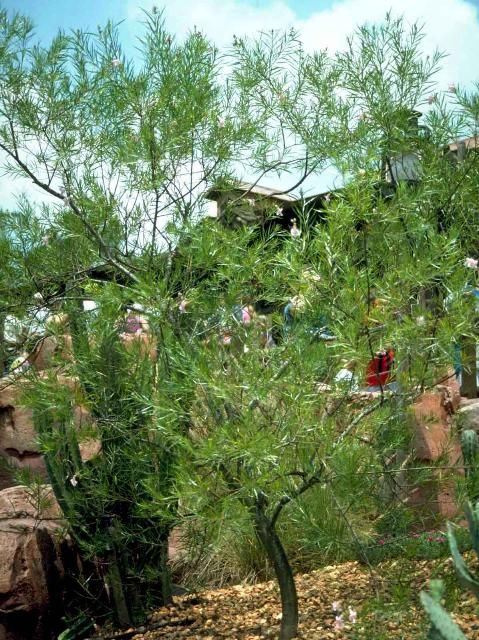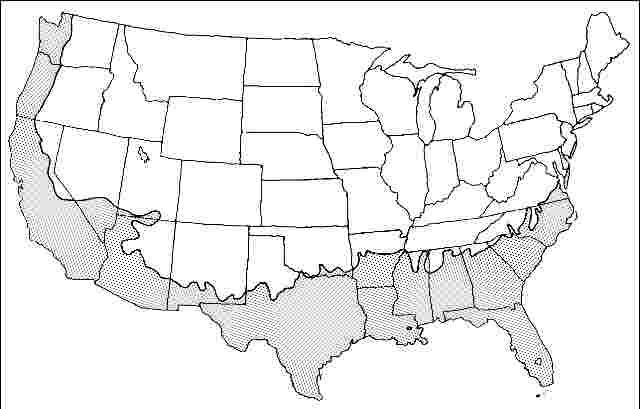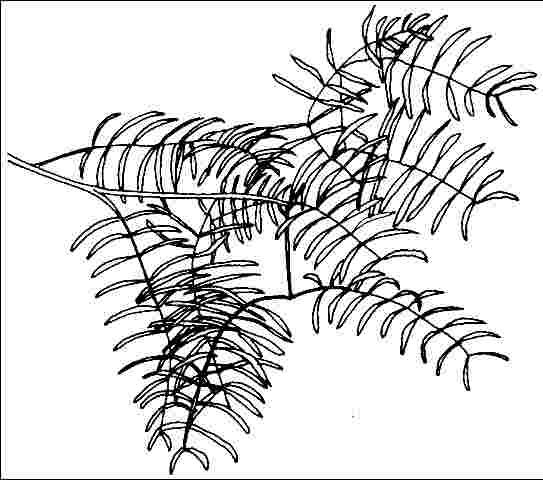Introduction
This native North American tree is well known in hot, dry areas where the soft, willow-like leaves and beautiful blooms are a welcome relief. Desert willow reaches 30 feet in height and a width of 25 feet, with fairly loose, open branching. The narrow leaves are 5 to 12 inches long and, although deciduous, provide no appreciable fall color change.

Credit: Ed Gilman, UF/IFAS
General Information
Scientific name: Chilopsis linearis
Pronunciation: kye-LOP-sis lin-ee-AIR-iss
Common name(s): Desert willow
Family: Bignoniaceae
USDA hardiness zones: 7B through 11 (Fig. 2)
Origin: native to North America
Invasive potential: weedy native
Uses: reclamation; highway median; specimen; container or planter; deck or patio
Availability: somewhat available, may have to go out of the region to find the tree

Description
Height: 20 to 30 feet
Spread: 15 to 25 feet
Crown uniformity: irregular
Crown shape: round, spreading
Crown density: open
Growth rate: moderate
Texture: fine
Foliage
Leaf arrangement: opposite/subopposite (Fig. 3)
Leaf type: simple
Leaf margin: entire
Leaf shape: linear, lanceolate
Leaf venation: pinnate, parallel
Leaf type and persistence: deciduous
Leaf blade length: 4 to 8 inches, 8 to 12 inches
Leaf color: green
Fall color: no color change
Fall characteristic: not showy

Flower
Flower color: white/cream/gray, pink, lavender
Flower characteristics: showy
Fruit
Fruit shape: elongated
Fruit length: 3 to 6 inches, 6 to 12 inches
Fruit covering: dry or hard
Fruit color: tan, brown
Fruit characteristics: attracts birds; showy; fruit/leaves not a litter problem
Trunk and Branches
Trunk/bark/branches: branches droop; not showy; typically multi-trunked; thorns
Pruning requirement: needed for strong structure
Breakage: resistant
Current year twig color: green
Current year twig thickness: thin
Wood specific gravity: unknown
Culture
Light requirement: full sun
Soil tolerances: clay; sand; loam; alkaline; acidic; well-drained
Drought tolerance: high
Aerosol salt tolerance: unknown
Other
Roots: not a problem
Winter interest: no
Outstanding tree: yes
Ozone sensitivity: unknown
Verticillium wilt susceptibility: unknown
Pest resistance: free of serious pests and diseases
Use and Management
Unlike the weak wood of true willows, the wood of desert willow was used by Native Americans to craft their hunting bows. The wood has also been used for fence posts, and baskets are often woven from the twigs. It is the blossoms of desert willow that help make it so special, though, with the showy, 2- to 4-inc-long clusters of 1- to 1.5-inch-long, trumpet-shaped blooms appearing from late spring to early fall or only during the summer if rainfall is sparse. The blooms occur at the tips of the branches and on new growth. The extremely fragrant, orchid-like blooms are most often seen in shades of lavender and pink, but a white variety is occasionally found. The bees find the blossoms irresistible and a delightful honey is produced from the flowers. The narrow, 4- to 12-inch-long seed capsules that follow persist on the tree, and the seeds are quite popular with birds.
The multi-trunked, well-branched habit of growth and thick growth make desert willow well suited for a wide screen or tall hedge. Groups can be planted in a large-scale landscape for a splash of color. The tree has also been popular in residential plantings as specimens.
Desert willow should be grown in full sun and is extremely drought tolerant. While the trees will grow better with adequate moisture, they will not tolerate overwatering.
Cultivars include 'Dark Storm'—burgundy; flowers and 'Pink Star'—bright pink flowers.
Propagation is done easily by cuttings.
Pests and Diseases
No pests or diseases are of major concern.